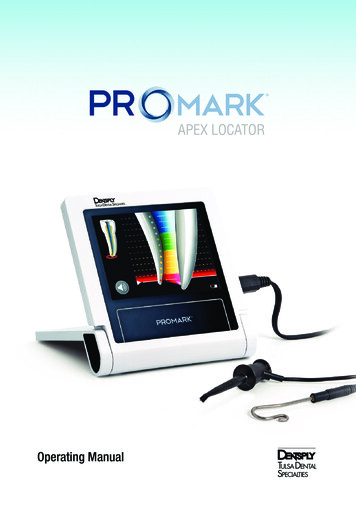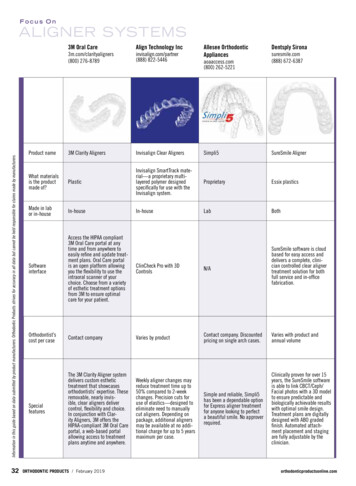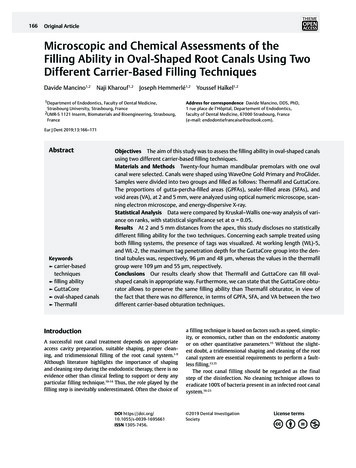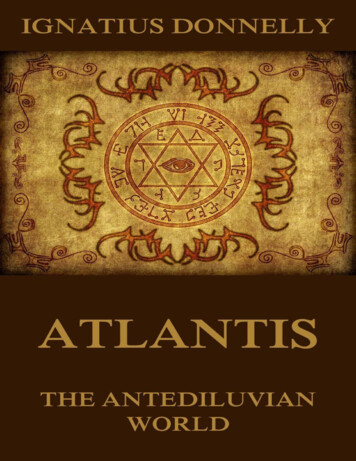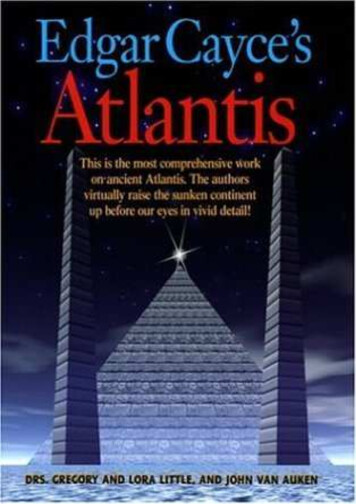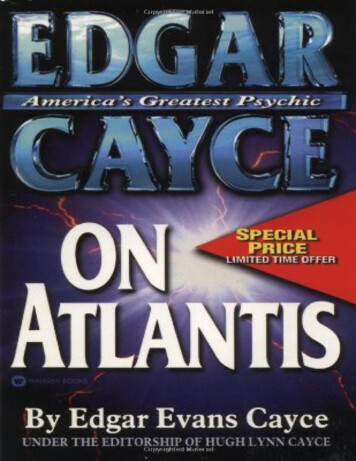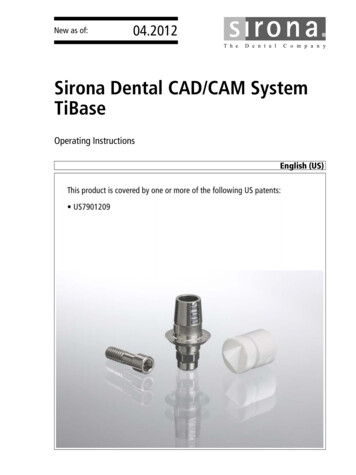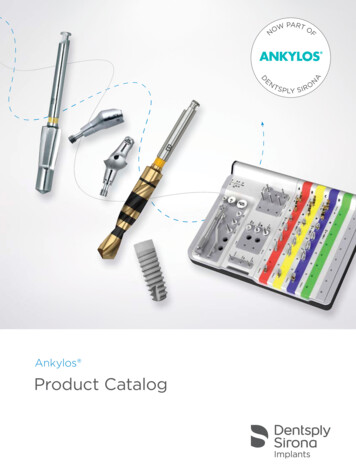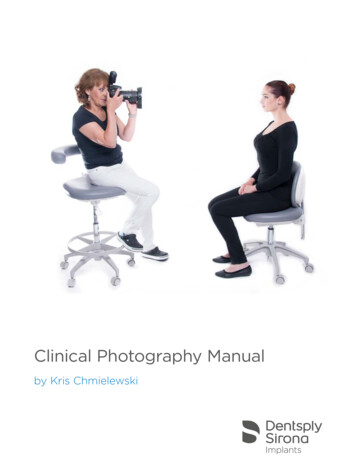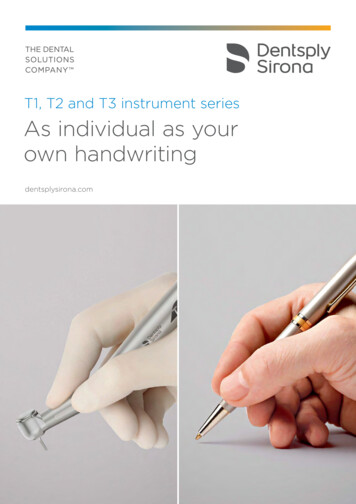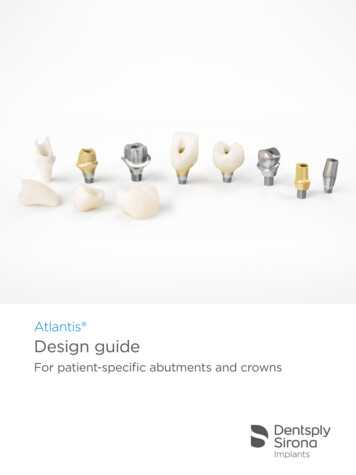
Transcription
Atlantis Design guideFor patient-specific abutments and crowns
Atlantis CONTENTSThis manual provides an instructional overview of laboratory proceduresand design options for Atlantis patient-specific abutments and crowns.Atlantis abutments can be designed and produced for all major implantsystems* and are available in titanium, gold-shaded titanium and zirconia.Introduction4Atlantis patient-specific abutments4Virtual Atlantis Design (VAD)4Laboratory procedure5Anatomy6Emergence shape options6Emergence width options7Abutment outcomes10Implant placement10Additional options11Abutment design parameters12Atlantis Abutment13Atlantis Crown, Cut-back14Atlantis Crown, Full-contour15Atlantis Crown File16Atlantis Core File17Atlantis Insertion Guide18Atlantis Crown AbutmentAtlantis CustomBase solution1920Atlantis CustomBase solution – Atlantis Core File21Atlantis CustomBase solution – Atlantis Crown22Atlantis CustomBase solution – Atlantis Crown File22Atlantis Conus Abutment – overdenture23Atlantis Conus Abutment – custom25Duplicate abutment26Later order26Models and diagnostic wax-up27Articulator guide28Design terminology29Questions & Answers30* Refer to the latest version of Atlantis implant compatibility chart in Atlantis WebOrder.To improve readability for our customers, Dentsply Sirona does not use or in bodycopy. However, Dentsply Sirona does not waive any right to the trademark and nothingherein shall be interpreted to the contrary.3
IntroductionIntroductionAtlantis patient-specific abutmentsAtlantis abutments are available for cement-, screw- and attachmentretained, implant-supported restorations for all major implant systems*.All abutments are delivered with the corresponding abutment screw.Virtual Atlantis Design (VAD)Using the patented Virtual Atlantis Design (VAD) software, the abutmentsare designed from the final tooth shape, which is a significant advantagefor achieving a more natural, esthetic result and optimized function.Atlantis Abutment and crownsFor cement-retained crown or bridge restorationsavailable in titanium, gold-shaded titanium andfour shades of zirconia.**Atlantis Crown AbutmentFor single-tooth, screw-retained crowns, available intitanium and five shades of zirconia, including atranslucent zirconia in white.**Atlantis CustomBase solutionFor screw-retained restorations, available in titaniumand gold-shaded titanium. For additional productdetails, see page 20.Atlantis Conus Abutment – overdentureFor attachment-retained restorations utilizing afriction fit. Designed to fit SynCone 5 caps. Availablein titanium.Atlantis Conus Abutment – customFor attachment-retained restorations utilizing afriction fit, with more individual design options.Available in titanium and gold-shaded titanium.* Refer to the latest version of Atlantis implant compatibility chartand Atlantis WebOrder.** Images shown for communication purposes only and should notbe used as a representation of the exact material color.4
Laboratory procedureLaboratory procedureThe information below provides a step-by-steplaboratory procedure for ordering an Atlantisabutment.Contact your local Dentsply Sirona representative forassistance with your first orderor to request support materials: Training on how to use Atlantis WebOrderAtlantis WebOrder user guideAtlantis CaseSafe boxes for shipping your casesInformation regarding lab-based and intraoralscanning for Atlantis abutments1. Working model and scanningThe model should have a removable, stable silicone soft tissue mask.(For more information, see page 20.)If scanning the model at the dental laboratory or receiving intraoralscanning files from the clinician, please refer to the user guide for thescanner in use to provide the needed scan files. The user guides canbe found at the help page at Atlantis WebOrder.If physical models are shipped, a small articulator/occludator can beused and shipped in the Atlantis CaseSafe box provided. All casesneed to be articulated, a diagnostic wax-up can replace the opposingmodel but a model is preferred.If using an articulator with a removable base plate, it is only necessaryto ship the model mounted on the plate and not the entire articulator.2. Atlantis WebOrderEnter your order in Atlantis WebOrder* (www.atlantisweborder.com),and personalize the design to the patient s specific needs by modifyingthe abutment design preferences. If physical models are shipped, printand send the order ticket with the models in an Atlantis CaseSafe tothe Atlantis manufacturing facility in Waltham, MA.3. DesignOnce your models are received, they are scanned and generated intoa virtual 3D image that is then used for the individual design of theAtlantis abutment in Virtual Atlantis Design (VAD) software.4. ManufacturingUpon your approval of the virtual abutment design (if requested),your Atlantis abutment is manufactured and measured to checkthat the milling was done according to the specifications and withinthe tolerances.Finally the milled abutment is verified towards the order you enteredin Atlantis WebOrder and the Virtual Atlantis Design (VAD) software.5. Final restorationWhen the abutment is received at the lab, the final restoration can befabricated.Note: The Atlantis abutment screw delivered with the abutment shouldalways be used by the clinician for final seating of the abutment in themouth. In Atlantis WebOrder, extra screw(s) can be ordered togetherwith each case to be used in the laboratory during fabrication of thefinal restoration.* New users must register to access Atlantis WebOrder. Click on the “Register” link tostart the process.5
Anatomy/emergence shapeAnatomyTeeth are not round. In order to create implantrestorations that look and function like natural teeth,anatomically shaped abutments allow you to provideresults of the highest esthetics and function.Virtual Atlantis Design (VAD) imagesReference:Wheeler s Dental Anatomy, Physiology andOcclusion, Major M. Ash, Stanley NelsonAtlantis abutments are designed to correspond with the shape of naturalteeth. Customer preferences together with the Virtual Atlantis Design(VAD) software are used to create individual abutments for each patientand situation.Emergence shape optionsConcaveThe shape between the interface and the margins(preparation line) will be concave, in order to reducetissue pressure.Note: If no selection is indicated in your order, theAtlantis abutment will be fabricated with this shapeby default.StraightThe shape between the interface and the margins(preparation line) will be straight.ConvexThe shape between the interface and the margins(preparation line) will be convex.6
Emergence width optionsEmergence width optionsThe design of Atlantis abutments is based on severalfactors, including the size of the healing space,the emergence width option chosen during orderplacement and the position of the restorative margin.The healing situation can vary depending on thesize of the healing abutment used. It is thereforeimportant to choose the appropriate emergence widthoption that will create the abutment size needed toeffectively support the final restoration.For example, the combination of narrow healingsituations and larger crown restorations could requirethe selection of the “Full anatomical dimensions”emergence width option, but may cause highcompression on the soft tissue. A surgical incision maybe required to seat the abutment.1. No tissue displacementAbutment with no soft tissue support. The abutmentdoes not touch the soft tissue.Note: If a stone model of the soft tissue is provided,the abutment can only be designed with thisemergence width option.Narrow healing spaceThe design of the abutment may be smallerthan desired due to the required smoothing ofthe emergence shape.The abutment will nottouch the soft tissue.Wide healing spaceIn a larger sized healing situation, the abutmentwill be larger, but the abutment will not touchthe soft tissue.7
Emergence width options2. Support tissueAnatomically-shaped abutment up to 0.2 mm largerthan the sulcus of the silicone soft tissue modelprovided.The size of the abutment will be determined by thespace created by the healing/temporary abutment foran “easy” insertion.Narrow healing spaceThe design of the abutment will apply light pressure on the soft tissue. A narrow healingspace will result in a smaller sized abutment.Wide healing spaceThe design of the abutment will apply light pressure on the soft tissue. A larger healingspace, will result in a larger sized abutment.3. Contour tissueMedium diameter, anatomically-shaped abutment upto 1.0 mm larger than sulcus of model of soft tissueprovided.The size of the abutment is determined by thespace created by the healing/temporary a butment.The design of the abutment may cause temporaryblanching of the soft tissue.Note: If no selection is indicated in your order,the Atlantis Abutment will be fabricated with thisemergence width option by default.Narrow healing spaceThe abutment design will have a maximum of1.0 mm of soft tissue compression. A narrowhealing space will result in a smaller sized abutment.Wide healing spaceThe abutment design will have a maximum of1.0 mm of soft tissue compression. A largerhealing space will result in a larger sized abutment.8
Emergence width options4. Full anatomicalLargest diameter abutment provided with best emergence profile possible.The design of the abutment is based on the bestemergence profile possible, not taking the soft tissuesituation into consideration.Narrow healing spaceCan create a high compression when there isa narrow healing space. A surgical incision forplacement may be required.Wide healing spaceIn situations with a wider healing space, thecompression on the soft tissue will be less5. Anatomical supportAbutment with the least soft tissue compression,using maximum concave emergence shape, anddesigned based on following criteria: The size of the abutment is determined by the bestemergence profile possible. The margins (preparation line) will be placed atgingiva level or just below gingiva level. The emergence shape will be as concave as possible.Narrow healing spaceIdeal situation for the use of Anatomicalsupport; narrow healing space compared to the edentulous situation in the “non-esthetic” zone.Note: Not applicable on wide healing situations.Abutment outcome9
Abutment outcomes/implant placementAbutment outcomesDepending on the soft tissue situation, your selectionof emergence width option may result in significantdifferences in the abutment size.A – Full anatomicalB – Contour tissue*C – Support tissueD – No tissue displacement*Default if no selection is madeNarrow healing spaceABCDThere may be more significant differencesin the abutment design between each of theemergence width options.Wide healing spaceABCDThere will be smaller differences in theabutment design for each of the emergencewidth options.Implant placementWhen the implant is placed in a non-ideal position,the choice of margin position and emergence widthoption has a great influence on the outcome of theabutment. The most common situations are describedand illustrated below.Shallow implant placementWhen minimal soft tissue depth is availableand a subgingival margin position is selected,the total abutment width will be limited.Note: A supragingival margin together withemergence width option “full anatomicaldimensions” or “contour soft tissue” will createa wider abutment, but may result in exposedabutment margins. Emergence width option“anatomical support” is not applicable forshallowly placed implants.Off-center implant placementWhen the implant position is off-centercompared to the required final toothrestoration, the Atlantis abutment can bedesigned to compensate for the off-centerplacement through the selection of eitheremergence width option full anatomicaldimensions or contour soft tissue, whichwill allow for a higher compression of thesoft tissue.10
Additional optionsAdditional optionsMargin position optionsUse subgingival depthMargin depths measuredfrom gingival crest toabutment margin.Use heights aboveinterfaceMargin depths measuredfrom implant surface toabutment margin.Margin designAs close to interface aspossible.Use neighboring teeth.Margin bevelRetentive surface15 0.25 mm0.5 mm0.01 mmShoulderChamferGingival bevel(not available in zirconia)Retentive surface titanium(not available in zirconia)Parallel abutmentsIf the final restorations for a case will be splinted, theabutments must be designed to be parallel. Whenordering mutiple Atlantis abutments for an individualcase, be sure to indicate which abutments should beparallel to each other. Requests of having abutmentsdesigned parallel to prepared teeth can be made butparallelism cannot be guaranteed.11
Additional optionsAbutment design parametersAbutment material: TitaniumThe abutment diameter ranges from 3.3 to 12 mm, the maximumabutment height is 15 mm above the implant interface andthe minimum height is 4 mm above the transmucosal collar.The abutment is provided straight and up to 30 of angulation.Abutment material: ZirconiaThe abutment diameter ranges from 3.45 mm to 9.50 mm, themaximum abutment height is 13.8 mm above the implant interfaceand the minimum height is 4 mm above the transmucosal collar.The abutment is provided straight and up to 30 of angulation.Note: The values mentioned above (for both abutment materials)are case dependent, meaning that they vary from case to case.For example, a titanium abutment that is angled 30 from theimplant direction is not possible to design 15 mm high.12
Atlantis AbutmentAtlantis AbutmentFor cement-retained crown or bridge restorations,available in titanium, gold-shaded titanium and fourshades of zirconia.Atlantis abutments offer several advantagescompared to stock abutments: Different choices of emergence widths for a naturaland esthetic result Margins can be placed at an ideal level for easy andsafe removal of excess cement Require no chair side modification Produced by state-of-the-art milling process toensure highest precision and quality – every time Eliminate the time needed for managing a prefabricated abutment inventoryOrder preference defaultsWhen ordering your Atlantis Abutment in AtlantisWebOrder, defaults can be set for most of the designpreferences. You can change preferences on anaccount level as well as within each individual order.If no preferences are set, the defaults listed belowwill be used when designing the Atlantis Abutment.See Atlantis WebOrder user guide for more details onchanging preference default settings.Order preferencesAvailabilityDefault settings*Images (for design approval)AvailableN/AModel (type)All availableN/AAtlantis Insertion GuideAvailableNoMaterialAll available**N/AEmergence width optionsAll availableContour soft tissueMargin position optionsAll availableUse subgingival depth. B/F1.0 mm,D 0.75 mm, M 0.75 mm, L 0.50 mmMargin designAll availableChamferRetentive surfaceAvailable***Retentive surfaceAtlantis Core FileAvailableNoDuplicate abutmentAvailableNoParallelismAvailableN/ALater orderAvailableN/ADiagnostic wax-upAvailableRecommended for four (4) ormore edentulous spaces next toeach other* See Atlantis WebOrder user guide for more details on changing preference default settings.** May vary between implant brands and sizes. Please see Atlantis implant compatibility chart for details.*** Not available for zirconia.13
Atlantis Crown, Cut-backAtlantis Crown, Cut-backThe Atlantis Crown, Cut-back is a patient-specificcrown with space for porcelain veneering, intendedfor use with an Atlantis Abutment. Together, thesecomponents function as a full single-tooth prostheticrestoration. The cut-back crown is veneered andfinalized by the dental laboratory, and cemented tothe Atlantis Abutment by the clinician as the finalstage of the prosthetic procedure.Porcelain cut-backMaterial and shadesTo optimize the porcelain support there is a set rangefor porcelain cut-back. Cut-back default values caneasily be changed within this set range in AtlantisWebOrder. This is a very important step in getting theexact preferred cut-backThe Atlantis Crown, cut-backs are milled in amonolithic medium translucent zirconia, Y-TZP(yttrium stabilized tetragonal zirconia polycrystals),with a coefficient of thermal expansion of10.6 x 10 -6/K-1.RegionRangeDefaultBuccal/Facial0.5 – 2.0 mm1.5 mmLingual0.5 – 2.0 mm1.2 mmDistal0.5 – 2.0 mm1.5 mmMesial0.5 – 2.0 mm1.5 mmOcclusal0.5 – 2.0 mm1.5 mmIncisal0.5 – 2.0 mm1.5 mmNote: Cut-backs may be further altered within the specified rangeby the Abutment Design Technician in orderto achieve a more ideal abutment core size and to maintain theminimum crown wall thickness of 0.4 mm.The crowns are available in thirteen differenttranslucent shades of zirconia. These are developedto resemble the shades on the Vita shade guide(refer to shade guide when entering the order inAtlantis WebOrder).Porcelain applicationThe porcelain used for veneering of the cutback crowns should be applicable for zirconia(see “Material” above), and must be appliedand processed in accordance with the IFU fromthe manufacturer of the porcelain/stain used.Additional informationThe Atlantis Crown, cut-back s are made with acement space of 40 µm.14
Atlantis Crown, Full-contourAtlantis Crown, Full-contourThe Atlantis Crown, Full-contour is a patient-specificcrown intended for use with an Atlantis Abutment.Together, these components function as a full singletooth prosthetic restoration. The full-contour crownmay be stained and glazed by the dental laboratory,and cemented to the Atlantis Abutment by theclinician as the final stage of the prosthetic procedure.Material and shadesCement space and Crown cementationThe full-contour crowns are milled in a monolithichigh translucent zirconia, Y-TZP (yttrium stabilizedtetragonal zirconia polycrystals), with a coefficient ofthermal expansion of 10.6 x 10 -6/K-1.Cement should be appropriate for both the abutmentand crown material. Perform cementation inaccordance with the IFU from the manufacturer ofthe cement used. The Atlantis Crown, Full-contour ismade with a cement space of 40 µm.The crowns are available in thirteen different highlytranslucent shades of zirconia. These are developed toresemble the shades on the Vita shade guide.In Atlantis WebOrder it is possible to order the crownswith or without polished surface.Stain and glaze applicationStain and glaze may be applied to the Atlantis Crowns,Full-contour with the following stipulation: Should beformulated to have a CTE (coefficient of thermalexpansion) that is appropriate for zirconia (see section“Materials” above).Note: Application and processing must be carried outin accordance with the instruction for use from themanufacturer of the porcelain/stain used.Additional informationThe Atlantis design technicians will always strive toachieve as good occlusion as possible. However, ife.g. the occlusal contacts are too heavy the AtlantisCrown, Full-contour may be grinded by the dentallaboratory and/or clinician. Please note that theAtlantis abutments warranty will still be valid, even ifthe crown has been grinded.15
Atlantis Crown FileAtlantis Crown FileThe Atlantis Crown File is a patient-specific “readyto-mill” digital file of the cut-back or the full-contourcrown design, intended for use with an AtlantisAbutment. Together, these components function as afull single-tooth prosthetic restoration.The Atlantis Crown File is designed by the Atlantisdesign technicians in the patented Virtual AtlantisDesign (VAD) software. The crown file is thenuploaded to Atlantis WebOrder for the laboratoryto approve before the crown file is downloaded andmilled in the laboratory s in-house milling machine inthe preferred crown material.Two crown file versions:Cut-back or full-contourThe crown files are available as cut-back or as fullcontour. With the cut-back version the lab can chosefrom a set range of cut-back all sides of the crown(see page 13). After milling of the crown the crownUpload the crown file into the milling software, andproceed with the milling preparations according to theinstructions from the particular milling software.Note: Validation of the design and all design changesmust be done within Atlantis Editor before designapproval (no changes to the crown design can bedone after design approval).Minimum milling machine requirements16 5 axis milling machine A milling machine that can either handle over-millingor has a capacity to:– Mill down to 0.5 mm diameter in “net shape”(no sintering after milling)– Mill down to 0.6 mm diameter in “green state”(the crown is sintered after the milling)should then be veneered and finalized by the labbefore the cementation is done by the clinician.The full-contour crown may be stained and glazed bythe lab after the milling and should then be cementedby the clinician in the patients mouth.Crown file downloadIn Atlantis WebOrder you will be able to downloadthe crown file as soon as you have given the designapproval: he shrinkage factor depends on crown materialTand from which manufacturer the material comesfrom. Refer to the IFU from the crown material(puck) manufacturer Puck thickness of the crown material should beminimum 17 mm The crown files are delivered in STL-file format,which means that the milling software must be ableto process STL-files.
Atlantis Core File / Atlantis Abutment Insertion GuideAtlantis Core FileWhen fabricating the final restoration, you can simplydownload the Atlantis Core File, instead of scanningthe Atlantis Abutment yourself, allowing you to beginmanufacturing the crown/bridge before the abutmentarrives at the lab.Atlantis Core File is a high precision digital file of thetotal case, including the outer surface of an AtlantisAbutment and includes abutment design and allscanned data such as soft tissue, adjacent teeth andopposing dentition. Atlantis Core File eliminates theneed to scan the abutment and cast and enablesthe digital design of the coping and final restorationbefore even receiving the physical abutment. Ifpreferred, the core file can also be ordered as a laterorder after receiving the physical abutment. Availablein Atlantis WebOrder, Atlantis Core File can beordered for cement- or screw-retained restorations(with or without screw access hole location).3Shape, Dental Wings, DWOS Lava Edition, exocad oropen design software is required to import the file.The file is available both for single and multiple units(including pontics), however not for bridge cases thatinclude prepared teeth.Refer to the Atlantis Core File user guide for furtherinformation, available on the “Help” page in AtlantisWebOrder.Atlantis Insertion GuideThe Atlantis Insertion Guide is a precisely-crafted,3D-printed device that securely holds an AtlantisAbutment at the correct angle and orientation duringinstallation. The guide can be ordered for single- andmultiple-unit cases and is available for the followingproducts:Atlantis Abutment (for cement-retained restorations)Atlantis Conus Abutment - overdenture (forattachment retained restorations)Atlantis Conus Abutment – custom (for attachmentretained restorations)The insertion guide uses adjacent teeth (for single-unitcases) as an index and ensures precise and reliableabutment placement. The Atlantis Abutment scandata, provided by the patented Virtual Atlantis Design(VAD) is used to create the Atlantis Insertion Guide fora perfect design and fit.For convenience and security, the last digits in thecase number are engraved on each guide, and a flossloop allows for a piece of dental floss to be attached,ensuring predictable restorative procedures.Please refer to the document “Handling procedures forAtlantis Abutment” available in the “Help” section ofAtlantis WebOrder, which describes the laboratory andclinical procedure using the Atlantis Abutment with theguide (for single-unit cases).*Please note that it is not possible to produce insertion guides for fully edentulous cases,since at least one remaining tooth is needed for creation of the guide.17
Atlantis Crown AbutmentAtlantis Crown AbutmentFor single unit screw-retained restorations, ananatomical abutment for direct porcelain application(or composite for titanium) available in titanium andfive shades of zirconia including a translucent zirconiain white.Please consider the following when ordering anAtlantis Crown Abutment. You may also refer to theAtlantis WebOrder user guide for more information.RegionRangeDefaultDiagnostic wax-upBuccal/Facial0.5 – 2.0 mm1.2 mmWhen ordering an Atlantis Crown Abutment, a fullcrown, removable diagnostic wax-up is recommended.Lingual0.5 – 2.0 mm1.0 mmDistal0.5 – 2.0 mm1.0 mmMesial0.5 – 2.0 mm1.0 mmOcclusal0.5 – 2.0 mm1.2 mmIncisal1.0 – 3.0 mm1.5 mmPorcelain cut-backTo optimize the porcelain support there is a set rangefor cut-backs. This range cannot be altered.Cut-back default values can easily be changed withinthis set range in Atlantis WebOrder.Note: Cut-backs may be further altered within thespecified range by the Abutment Design Technician inorder to achieve a more ideal abutment size.Example:By decreasing the porcelain cut-back on the lingualside, the length of the abutment is increased foreffective support of the porcelain/composite.18Porcelain/composite cut-backs have to be less onsmaller teeth such as lower incisors, upper laterals andin narrow situations to ensure sufficient material forthe abutment core.
Atlantis Crown AbutmentAngled implant placementsThe angle of the implant may limit the possibility touse a screw-retained restoration. It is recommendedto check the model with a guide pin or similar beforeselecting this restoration type.The more angled the placementof the implant, the harder it will beto place a screw-retained crown,as the path of insertion mayinterfere with the adjacent teeth.Depending on the position of the implant, the screw access hole mayinterfere with esthetic and functional outcome of the final crown.MaterialA mask should be used to assure that no porcelain/stain/composite gets on the areas of the interface.Incorrect application of the porcelain/stain/composite could compromise the fit and/or strengthof the assembly. Whenever possible, the AtlantisCrown Abutment should be placed in an implantreplica during porcelain application to avoid the risk ofporcelain particles in the connection area.Note: It is very important to correctly adjust contactpoints as the crown is in one piece and has to alignperfectly with the implant to prevent failure.Atlantis Crown Abutment – zirconiaYttria-stabilized tetragonal zirconia polycrystals(Y-TZP)Atlantis Crown Abutment – titaniumTitanium Alloy 6AI-4V (Grade 5).Carefully follow the porcelain and compositemanufacture protocol.Firing porcelain on Atlantis Crown Abutment intitanium creates an oxide layer. If the oxide layer needsto be removed, the implant abutment connectionproperties must not be changed. Blasting carefullywith aluminium oxide 50 µm or glass beads, maximum2 bar pressure.Note: Not available for gold-shaded titanium, sinceporcelain cannot be fused to TiN (titanium nitride).Gold-bonder is not recommended for TitaniumGrade 5.Thermal linear expansion of 10.6 x 10 -6/K-1Due to the integrated screw, Atlantis Crown Abutmentfor Ankylos is not available.Use appropriate porcelains made for these materialconstraints.RemindersApplication and processing must be carried out inaccordance with the instructions for use from themanufacturer of the porcelain/stain used.Note: The use of zirconia abutments should generallybe carefully evaluated before placed in situations withunfavorable loading conditions in combination withsmall interface diameters. Further changes to porcelain cut-backs may bemade by the Abutment Design Technician. In the event that a screw-retained solution is notpossible due to limitations of the implant case andan Atlantis Crown Abutment was ordered, you willbe contacted by a customer support representative.19
Atlantis CustomBase solutionAtlantis CustomBase solutionAtlantis CustomBase solution is a patient-specificdental prosthetic component consisting of an AtlantisCrown, an Atlantis Abutment and Atlantis Abutmentscrew intended for use with an endosseous implant.Together, the bundled components function asa full single-tooth restoration for screw-retainedrestorations.The Atlantis CustomBase solution, is available with:Atlantis Crown (cut-back or full-contour withscrew access hole)Atlantis Crown File (cut-back or full-contourwith screw access) andAtlantis Core File (with screw access location)This solution differs from a cement-retainedrestoration. The abutment and crown are designedat the same time and should be regarded as one unit,similar to an Atlantis Crown Abutment.The material junction: The placement of materialjunction considering biological principles to ensurehealthy soft tissue conditions.Cementoenamel Junction (CEJ): The point in therestoration where the root-form transitions to thevisible tooth form. Similar to where the margin isplaced for abutment in a cement-retained restoration.Emergence profile shape (EPS): Solution is designedwith customized emergence profile for enhanced softtissue management. Patient-specific transmucosalemergence profile from implant level to up to themarginal gingiva, is specifically important for caseswith limited space and when esthetics is in focus.Material junctionCEJ –CementoenamelJunction20EPS – Emergenceprofile shapeAtlantis Abutment material: The abutment is availablein titanium or gold-shaded titanium.Note: For full interface compatibility, please refer tothe Atlantis abutments implant compatibility chart.Atlantis Insertion Guide: Not available for screwretained restorations.Cementation: The crown with a screw access channelis cemented to the Atlantis Abutment extraorallyby the dental laboratory or the clinician, to create ascrew-retained restoration. The parts sha
Abutment outcomes 10 Implant placement 10 Additional options 11 Abutment design parameters 12 Atlantis Abutment 13 Atlantis Crown, Cut-back 14 Atlantis Crown, Full-contour 15 . Atlantis Conus Abutment - custom 25 Duplicate abutment 26 Later order 26 Models and diagnostic wax-up 27 Articulator guide 28
